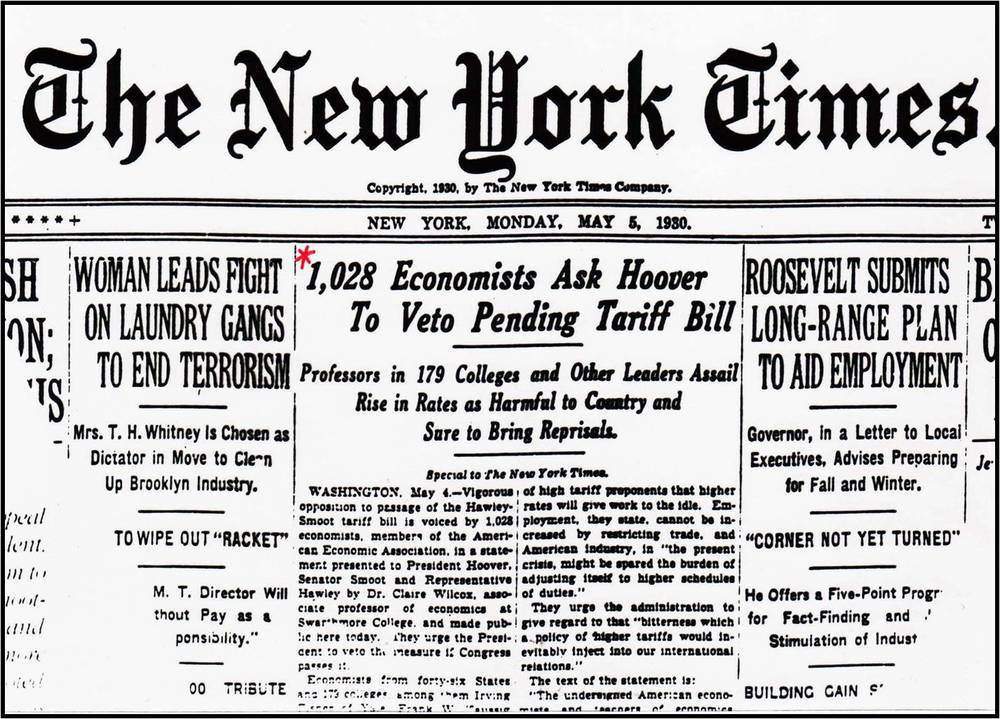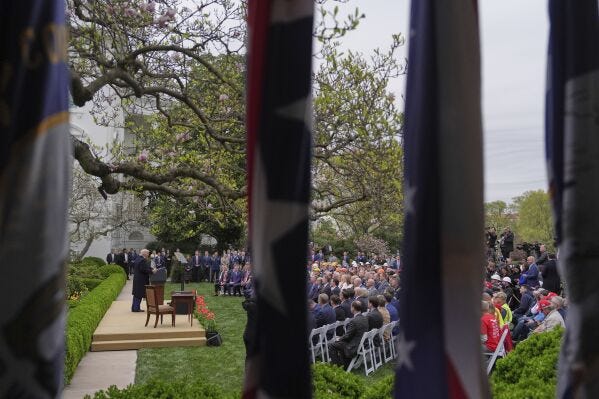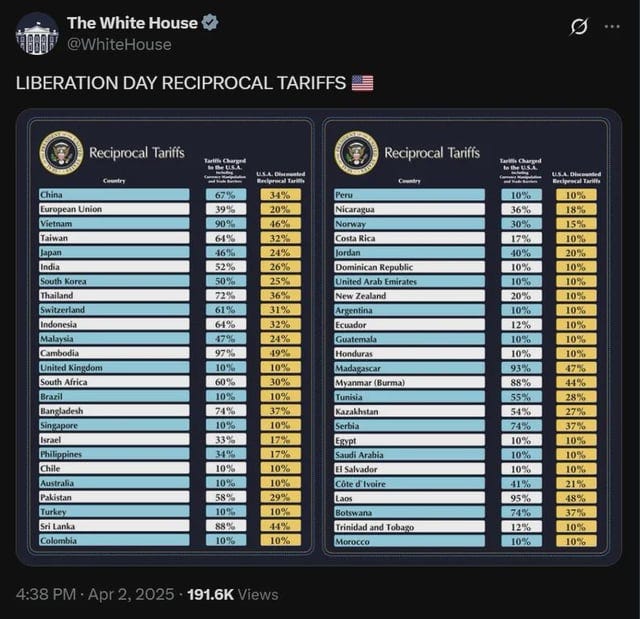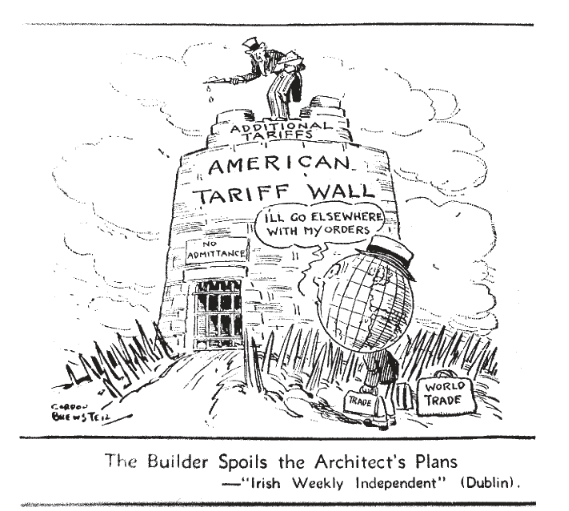How Trade Wars Foment Real Wars
How we're repeating the mistakes that led to WWII, and is this setting the stage for WWIII?
Preface
Not long after the 2024 presidential election results, I wrote a viral Threads post reflecting back on the devastating 1930 Smoot Hawley Tariff that ushered in the Great Depression and created the global economic conditions that laid the tinderbox for WWII.
Now that the tariffs have been fully announced, I’m following up with a deeper analysis of the potential geopolitical implications, beyond the retaliatory economic consequences, that show we’re heading down the same path. This will not end well in any case.
Let’s dig in. Brace yourselves.
The 2025 "Economic Independence" Plan and Its Global Implications
A Dangerous Declaration
Yesterday, on his so-called “Liberation Day”, Trump unveiled what he called a "Declaration of Economic Independence" — a sweeping new tariff regime that threatens to reshape global trade. Make no mistake: this will be effectively one of the largest consumer tax ever unleashed in America, essentially bringing us back to the Gilded Age robber baron era of the late 1800s.
What’s more — usual tariffs require Congressional approval. In this case, Trump invoked national security powers under a “continuing state of emergency” to circumvent Congressional approval. Don’t ignore this overlooked detail — this tactic is straight out of Hitler’s playbook that allowed him to consolidate dictatorial powers after the Reichstag fire, citing “emergency powers”, without the need for the Reichstag’s approval.
This plan includes the following, but not limited to, reciprocal tariffs:
A baseline 10% tariff on all imports
China: 34% (on top of the existing 20%)
European Union: 20%
Japan: 24%
Vietnam: 46%
India: 26%
Taiwan: 32%
United Kingdom: 10%
Foreign-made automobiles: 25%
The Immediate Fallout
Within hours, global markets began their descent. Australia's S&P/ASX 200 dropped over 2% and Asian markets tanked, signaling fears over a global economic trade war showdown. Economists project U.S. inflation could jump by an additional 1% as consumer prices rise across virtually every sector, which will stifle economic growth. Today, the Dow crashed 1700 points, reeling from the announcement.
To quote Paul Krugman, Nobel Prize-winning economist:
Trump's tariff announcement was full-on crazy. Not only is he imposing higher tariffs than almost anyone expected, but he's justifying them with completely false claims about other countries' tariffs. I don't know where his numbers are coming from, but they have nothing to do with reality... It's a really bad day for the U.S. economy.
Trading partners have already prepped swift and severe responses, including:
The European Union: Already intends to impose duties on U.S. goods worth some $28 billion in mid-April in response to Trump's steel and aluminum tariffs. On this latest round of escalated tariffs, European Commission President Ursula von der Leyen said "we are now preparing for further countermeasures."
China stated it "firmly opposes" and "will resolutely adopt countermeasures to safeguard its rights and interests." A ministry spokesperson added: "There is no winner in a trade war, and protectionism leads nowhere."
Canada and Mexico are preparing their own countermeasures, escalating trade tensions. Though the Senate today passed a bill to remove tariffs from Canada, it is unlikely to pass in the House.
Japanese Prime Minister Shigeru Ishiba said "We're putting all options on the table in considering the most effective response."
Canadian Prime Minister Mark Carney vowed countermeasures. "We are going to protect our workers," he said. "In a crisis, it's important to come together and it's essential to act with purpose and with force."
Spanish Prime Minister Pedro Sánchez said "Europe will defend itself, we will act swiftly, proportionally and with unity."
The Glaring Absence of Russia
Notably absent from the list of tariffed nations is Russia—a glaring omission that raises significant geopolitical questions. At best, Russia is not on the list because trade is already dampened due to ongoing sanctions the global community, led by the US, applied to Russia at the onset of their Ukraine invasion. At worst, it further adds to the oft-discussed and growing body of evidence that suggests Trump is a Russian asset.
The Power Consolidation Hypothesis
Beyond economic considerations, some analysts view the tariff program through a different lens: as a mechanism for consolidating executive power. Critics argue that the tariff structure creates a system where exemptions and carveouts become powerful political tools.
In this circumstance, foreign nations and multinational corporations would have to seek special dispensation directly from the administration, creating opportunities for further corruption by extracting exemptions, concessions or loyalty in exchange for payouts.
This suggests that the tariffs serve a dual purpose:
As idiotic, deeply misguided economic policy
As leverage mechanisms that require entities to "come hat in hand" to negotiate special treatment that will no doubt personally enrich Trump and his corrupt cronies
This discretionary patronage system, resembling a “medieval King bestowing favors on his loyal lords”, can be used to reward allies and punish perceived adversaries.
This tariff policy is not out of left field - it’s part of a larger pattern of consolidating authority through economic mechanisms in the standard authoritarian/fascist takeover playbook.
These are not simply economic policy adjustments. They represent a fundamentally flawed shift in America's relationship with the global economy — one with profound consequences for decades to come, echoing historical parallels that should alarm us all.
Trade Wars and the March to Conflict
Trade policies have historically been catalysts for geopolitical conflict, yet this pattern is often overlooked in mainstream discussions. Tariffs and trade restrictions disrupt economic stability, create political tensions, and, when escalated, can lead to military confrontations. By mapping out the cause-and-effect patterns of historical tariffs, we can see that economic protectionism often triggers wars under the guise of "national interest."
Corn Laws & Opium Wars (1815–1846) – High food prices fueled unrest and drove Britain toward imperial expansion. China's resistance to opium imports led to British military intervention.
McKinley Tariff & Spanish-American War (1890) – Raised sugar tariffs hurt Cuba’s economy, fueling the rebellion. US economic interests pushed the nation into war with Spain.
Smoot-Hawley Tariff & WWII (1930) – Trade restrictions exacerbated the Great Depression, fueling extremism in Germany and Japan, and setting the stage for war.
US Trade Restrictions & Pearl Harbor (1941) – The US cut off Japan’s oil and steel, forcing a choice: economic collapse or war. Japan attacked Pearl Harbor.
Cold War Tariff Blocs (1945–1991) – Divided global trade (GATT vs. COMECON) reinforced economic and ideological capitalism vs. communism fault lines, sustaining the Cold War standoff.
1930: The Historical Blueprint We Should Fear
We've been down this path before, and the destination was catastrophic. Let’s explore the Smoot-Hawley Tariff further.
In 1930, despite warnings from 1,028 economists who signed a formal petition, Congress passed the Smoot-Hawley Tariff Act. The legislation raised tariffs on over 20,000 imported goods to protect American jobs and businesses. What followed was not prosperity but devastation.
The Collapse by the Numbers
U.S. trade collapsed by two-thirds within just four years
Global trade plummeted 66% between 1929 and 1934
U.S. exports crashed from $5.2 billion to $1.7 billion (equivalent to a drop from $94 billion to $30 billion today)
European imports to America fell from $1.3 billion to $390 million (about $23.5 billion to $7 billion in current dollars)
Behind these numbers were real human consequences:
Unemployment in America skyrocketed to 25%
Thousands of banks failed across the country
Farmers lost crucial export markets
Factories shuttered nationwide
Breadlines and soup kitchens became symbols of national misery
President Herbert Hoover, who signed the bill despite opposition, later came to deeply regret his mistake and confessed in his memoirs:
"I did what I could to prevent its passage and to reduce its provisions to a minimum."
The Global Contagion Effect
Economic nationalism proved virulently contagious:
Canada raised tariffs within weeks
Britain abandoned its long-standing free trade policies
France blocked American goods
More than 25 nations imposed retaliatory tariffs
What began as an attempt to protect American workers transformed into a global race to the bottom that benefited no one.
From Economic Warfare to Actual Warfare
While Smoot-Hawley didn't directly cause World War II, it helped create the economic conditions that made global conflict more likely:
Mass unemployment fueled public anger and desperation
Economic chaos created fertile ground for political extremism
Germany's economic collapse contributed to Hitler's rise
Japan, facing resource scarcity and trade barriers, pursued military expansion
"Beggar-thy-neighbor" policies destroyed international cooperation
The collapse of global trade deepened the Great Depression, setting the stage for conflict. Economic pain and political chaos are always a dangerous mix.
Economic historian Charles P. Kindleberger observed in his seminal work "The World in Depression, 1929-1939":
"The 1930s depression was so wide, so deep, and so long because the international economic system was rendered unstable by British inability and United States unwillingness to assume responsibility for stabilizing it." This vacuum of economic leadership contributed directly to the collapse of peace.”
Fast Forward to 2025: Are We Walking the Same Path?
Today's world is different, but the risks are just as severe—if not worse. The parallels to 1930 are striking, with several aggressive factors that make our current situation potentially more volatile:
Immediate Dangers
Aggressive Retaliation Ready: Trading partners are prepared to retaliate with unprecedented speed and precision. The EU, Canada, Mexico, and Asian economies have signaled immediate countermeasures, many already drafted and awaiting implementation.
Supply Chain Vulnerability: Modern manufacturing relies on complex global supply networks that, once disrupted, cannot be quickly replaced with domestic alternatives. The intricate interdependence of today's economy means disruptions cascade through systems in ways impossible in the 1930s.
Inflation Acceleration: Higher prices on imports will increase costs for American consumers and businesses, fueling economic stagnation at a time when many households are already financially stretched.
Pre-existing Geopolitical Tensions: Unlike in 1930, we now live in an era of rising multipolar conflict, where economic instability could accelerate global fractures that are already forming.
Economic Vulnerability: The U.S. economy is already exposed, with manufacturing, agriculture, and tech sectors deeply integrated into global trade networks that will be disrupted, potentially leading to widespread job losses across multiple industries.
Thank you for your readership: To further support my efforts and if you’re able to, consider upgrading to a paid subscription for less than a cup of coffee a month. I’m deeply appreciative of your support!
A Critical Systems View: Are We Setting the Stage for WWIII?
If the Smoot-Hawley tariffs helped create the economic tinderbox for WWII, are we witnessing a similar pattern today? Current geopolitical developments suggest troubling parallels:
Military buildup in the Indian Ocean: A growing presence of B-2 stealth bombers in Diego Garcia positions U.S. forces within striking distance of Iran, escalating tensions in an already volatile region.
Renewed rhetoric about "taking Greenland": This echoes expansionist rhetoric of past empires and could signal an aggressive geopolitical strategy tied to resource control in an increasingly contested Arctic.
China's potential response: As the primary target of U.S. tariffs, China faces difficult choices. Will it accelerate economic decoupling? Increase military pressure in the South China Sea? Target strategic U.S. industries or debt holdings?
Moreover, a leaked secret Pentagon memo from Hegseth a few days ago indicated that Taiwan was above all other topics in terms of military priority and to prepare options for war with China over Taiwan. The memo in some parts copies verbatim parts of the 2024 Heritage Foundation report. DOD is using it as guidance word for word. Not a coincidence that the co-author of the report, Alexander Velez-Green, is now the Pentagon's interim top policy official.
It's also, perhaps, not a coincidence that China has just recently finally solved the last major logistical hurdle to their landing operations on Taiwan- via a series of strategic barges they've linked as a bridge in the ocean that can support the landing of large numbers of vehicles and troops.
Global alliances shifting: Economic protectionism is pushing traditional allies toward new economic and military partnerships, reshaping global power dynamics that have maintained relative stability for decades. For ex: Japan has been increasing military spending and deepening military cooperation with Australia, UK, NATO, India, and Philippines precisely to counter China together, as the Indo-Pacific nations navigate a new cooperation framework with the US ceding global leadership and antagonizing longstanding allies.
Economic instability breeding conflict: As witnessed in the 1930s, economic despair can fuel nationalism, extremism, and ultimately war—a pattern that appears to be repeating across multiple regions today.
The Modern Context Makes This Worse
Today's world features several elements absent in 1930 that could drastically exacerbate negative outcomes:
Nuclear-armed nations with competing territorial claims
Cybersecurity vulnerabilities in critical infrastructure
Climate instability creating resource pressures and population displacement
Digital currencies that could bypass traditional economic sanctions
Automation that limits the job-creating potential of reshoring
Social media amplifying nationalist sentiment and economic grievances
National Security Implications: The Overlooked Dimension
Beyond pure economics, these tariffs raise significant national security concerns that weren't as prominent in the 1930s context:
Defense industrial base fragility: Many critical defense components rely on global supply chains that could be compromised by trade barriers and retaliation.
Intelligence sharing disruption: Economic tensions could strain intelligence cooperation between the Five Eyes and other security partnerships.
Weaponized interdependence: Nations targeted by tariffs may exploit their position in critical supply chains to exert pressure on the United States.
Technology development handicaps: Restricted access to global talent pools and innovations could slow US technological advancement in strategic sectors.
Diplomatic isolation: Trade conflicts could undermine the coalition-building necessary to address shared security challenges like terrorism, nuclear proliferation, and climate change.
Regional Impacts: Beyond the Headlines
The tariff impacts will vary dramatically by region, creating unpredictable second-order effects:
Rust Belt manufacturing: May see short-term job preservation but long-term competitiveness decline as input costs rise and export markets close.
Agricultural heartland: Likely to face severe export retaliation, as agricultural products are typically first targets in trade wars. Moreover, the Whirlpool Corp., a big Iowa employer, just announced over 600 layoffs on the back of these new tariffs, a major blow to the waning manufacturing industry in the state.
Border communities: Cities along the Canadian and Mexican borders could experience economic devastation as cross-border commerce grinds to a halt.
Tech hubs: May struggle with talent acquisition, component shortages, and market access restrictions in a fragmented global economy.
Port cities: Could see dramatic employment losses as shipping volumes decline and supply chains redirect.
These regional disparities could accelerate political polarization, complicating any future efforts to restore economic normalcy.
Lessons Unlearned: The Imbecilic, Non-Sensical “Logic” of Protectionism
The academic case for protectionism has been repeatedly disproven:
The "saving jobs" fallacy: For every job potentially saved through tariffs, many more are lost in industries that rely on imports or face retaliation.
The consumer tax reality: Tariffs function as regressive taxes, hitting lower-income households hardest as they spend proportionally more on goods.
The innovation penalty: Protected industries typically become less competitive and innovative over time.
The diplomatic cost: Economic relationships often underpin broader security cooperation, which these tariffs may undermine.
A Warning from the Past
History has shown that protectionist policies often backfire, leading to higher consumer costs, weaker economic growth and heightened global volatility and tension. The lessons from Smoot-Hawley and the Great Depression are clear: tariffs designed to "protect" an economy often do the opposite, dragging both the nation and the world into deeper turmoil.
The 2025 tariff plan is more aggressive than past trade wars, with even higher stakes in today's interconnected global economy. The world has changed, but economic fundamentals have not.
If we repeat history, the consequences could be even worse this time. New century. Same playbook. Bigger consequences.
What Happens Next?
As the world reacts to these new tariffs, key questions emerge:
Scenario 1: Rapid Escalation
Trading partners respond with increasingly severe measures, triggering a full global trade war that accelerates economic decoupling.
Scenario 2: Legislative Intervention
Congress may attempt to reassert its authority over trade policy, attempting to reign in these tariffs. Just today, Washington Senator Maria Cantwell and Iowa Senator Chuck Grassley announced a bipartisan measure to restore Congress’ power over tariffs. However, Trump loyalist Speaker Mike Johnson is threatening to block the efforts in the House.
Scenario 3: Market Pressure
Severe economic consequences could force policy reversals if financial markets, business leaders, and consumers create sufficient pressure.
Scenario 4: Negotiated Settlement
The tariffs could serve as leverage for new trade agreements, though the aggressive approach may poison diplomatic waters.
Scenario 5: Military Escalation
Economic conflict spills over into military posturing and potentially limited conflicts in contested regions as nations seek to demonstrate strength during economic vulnerability.
Critical Questions for the Coming Months
How will major US trading partners respond beyond their announced retaliatory tariffs?
Will this escalate into a full-blown global trade war that permanently reshapes commerce?
Can Congress or economic pressure halt this trajectory before irreversible damage occurs?
Are we setting the stage for a full-blown, large-scale conflict, much like Smoot-Hawley contributed to WWII?
Which industries and regions will bear the heaviest costs of this economic experiment?
Preparing for the Aftershocks
This isn’t simply an economic story—it's a geopolitical inflection point that could reshape the coming decade or more.
The lessons of history are clear: economic nationalism never creates prosperity but instead breeds conflict, raises prices, destroys jobs, and weakens security. The Smoot-Hawley tariffs stand as one of history's most thoroughly discredited economic policies, yet we appear determined to repeat this grave error.
As philosopher George Santayana famously warned: "Those who cannot remember the past are condemned to repeat it." The question now is whether we will heed this warning before the damage becomes irreversible.
This moment calls for vigilance, preparation and a clear-eyed understanding of how the consequences of economic decisions ripple through history. The stakes could not be higher.
Thank you for your readership: To further support my efforts and if you’re able to, consider upgrading to a paid subscription for less than a cup of coffee a month. I’m deeply appreciative of your support!
Sources & Further Reading
Bernanke, Ben S. Essays on the Great Depression. Princeton University Press, 2004. https://press.princeton.edu/books/paperback/9780691118208/essays-on-the-great-depression
Irwin, Douglas A. Peddling Protectionism: Smoot-Hawley and the Great Depression. Princeton University Press, 2011.
Kindleberger, Charles P. The World in Depression, 1929-1939. University of California Press, 1986.
Santayana, George. The Life of Reason: Reason in Common Sense. Scribner's, 1905.
Tooze, Adam. The Wages of Destruction: The Making and Breaking of the Nazi Economy. Penguin Books, 2008.
Corn Laws & Opium Wars (1815-1846)
Platt, Stephen R. "Imperial Twilight: The Opium War and the End of China's Last Golden Age." Knopf, 2018.
McKinley Tariff & Spanish-American War (1890)
Smith, Jason R. "The McKinley Doctrine: Protective Tariffs, Imperialism, and the Rebuilding of South America." Pax America, 29 Jan. 2021
US Trade Restrictions & Pearl Harbor (1941)
Miller, Edward S. "Bankrupting the Enemy: The U.S. Financial Siege of Japan Before Pearl Harbor." Naval Institute Press, 2022.
Barnhart, Michael A. "Japan Prepares for Total War: The Search for Economic Security, 1919–1941." Cornell University Press, 2019.
Cold War Tariff Blocs (1945-1991)
Irwin, Douglas A. "Clashing over Commerce: A History of US Trade Policy." University of Chicago Press, 2023.
"The European Free Trade Association." CVCE (Centre Virtuel de la Connaissance sur l'Europe), University of Luxembourg.









Yeah. It’s not hard to imagine China acting on Taiwan much sooner than before idiot incompetent boychild.